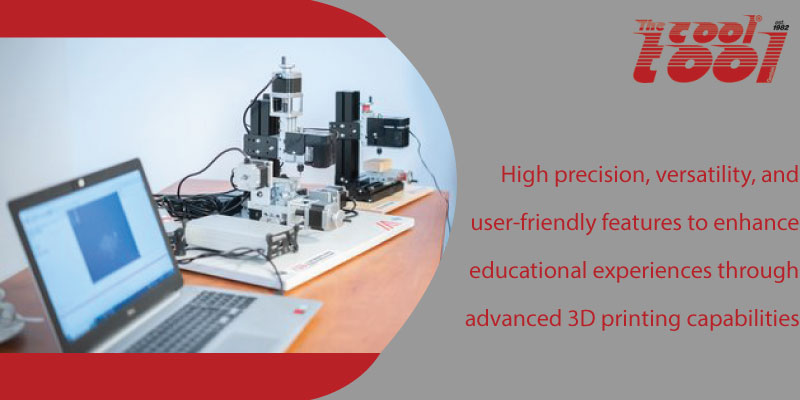Introduction to 3D Printing
3D printing or additive manufacturing is an innovative process that builds the three-dimensional object layer by layer with the help of a digital model. 3D Printing in Education has revolutionized various fields and holds immense promise for transforming learning experiences for both students and teachers.
Benefits of 3D Printing in Education
- Enhanced Engagement and Motivation: 3D printing grabs students’ attention and keeps them interested. By turning abstract ideas into physical models, students can see and grasp complex topics better. 3D printing grabs students’ attention and keeps them interested. By turning abstract ideas into physical models, students can see and grasp complex topics better.
- Hands-On Learning: 3D printing in education promotes hands-on learning experiences, allowing students to design, create, and iterate their projects. This practical method helps cement book knowledge and build problem-solving abilities.
- Cross-Disciplinary Applications: The versatility of 3D printing makes it applicable across various subjects. In science, students can print models of molecules or fossils; in mathematics, they can create geometric shapes; in history, they can recreate historical artifacts. This cross-disciplinary approach fosters a comprehensive understanding of topics.
- Encourages Creativity and Innovation: With 3D printing, students can make their ideas real, which sparks creativity. They learn to think and design fixes to real-world issues getting ready for future jobs in science and tech fields.
- Cost-Effective Prototyping: It provides an affordable way for students to prototype their designs. This allows for multiple iterations and experimentation without the high costs associated with traditional manufacturing methods.
Unimat 3D Printer: UNI-PRINT-3D
The Unimat 3D Printer, UNI-PRINT-3D, by Cool Tool Education, is an advanced tool developed from the proven Unimat CNC System. This 3D printer stands out for its exceptional stability, accuracy, and user-friendly features, making it an ideal choice for educational settings.
Key Features and Specifications
- High Precision and Stability: The UNI-PRINT-3D boasts a high layer resolution of over 20 microns, ensuring detailed and accurate prints. Its full metal frame and sturdy construction contribute to its stability, allowing for precise and consistent production of models.
- Versatile Printing Capabilities: This printer supports all common filaments, including PLA (Polylactic Acid), ABS (Acrylonitrile Butadiene Styrene), Nylon, and Laybrick.
- Temperature-Controlled Print Bed: The temperature-controlled aluminum print bed can reach up to 150°C, allowing for better adhesion. This feature ensures high-quality prints every time.
- Open Source Software: The UNI-PRINT-3D is made to operate on an open-source software called, Machinekit. This software platform is compatible with Windows, OSX, Linux, and Android. The cross-platform user interface offers flexibility and ease of integration with various devices.
- Advanced Connectivity: Connectivity options include USB, Ethernet, and WiFi, making it easy to transfer files and control the printer remotely. Autonomous printing capabilities allow the printer to operate independently once the print job is initiated, freeing up time for educators and students to focus on other tasks.
- Enhanced User Experience: The UNI-PRINT-3D which is available in schools across Dubai and the Middle East, is equipped with LEDs for illumination and color-coded signaling. This technology provides clear visual indicators of the printer’s status. These features enhance the user experience and make the printer more accessible to students.
STEM Projects for Different Subjects Using a 3D Printer
Science Projects
3D printing in education opens up numerous possibilities for science. By printing 3D models of molecules, students can visualize and understand complex chemical structures and bonds, enhancing their grasp of chemistry concepts. In biology, detailed models of human organs, bones, and other anatomical structures can be created to facilitate a deeper understanding of human anatomy.
Technology Projects
In technology education, 3D printing is a game-changer. Students can design and print custom parts for building and programming robots, giving them hands-on experience in robotics and engineering. Furthermore, printing holders and organizers for circuit boards and electronic components help students manage their projects more efficiently and learn about the practical applications of technology.
Engineering Projects
3D printing has a big impact on engineering students. It gives them a chance to make small versions of bridges, buildings, and other structures. This helps them learn about engineering ideas. They can also print gears, levers, and other machine parts. With these, they can build working models and machines. This hands-on approach lets them grasp how mechanical systems work.
Mathematics Projects
Mathematics topics can be significantly enriched through 3D printing in education. Students can print various geometric shapes and solids to explore geometry concepts, making abstract ideas more concrete. Creating models of complex mathematical surfaces and functions helps students visualize and better understand higher-level mathematics.
The UNI-PRINT-3D also known as the Unimat 3D Printer, has a big impact on learning. It prints with high accuracy, works for many purposes, and is easy to use making it a great fit for schools and colleges. When teachers bring 3D printing into their lessons, it helps students to think diffrently, come up with new ideas, and better grasp tough topics.






Recent Comments